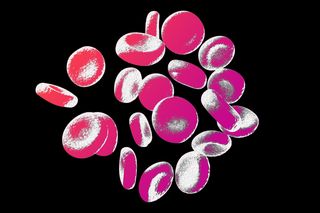
‘Smart’ Red Blood Cells Could Address The Antibiotic Resistance Crisis, Scientists Say
Scientists conceal antibiotics within red blood cells for targeted treatment — a finding that could help tackle drug-resistant bacteria with fewer side effects.

Physicists at McMaster University recently modified red blood cells and tested their potential as drug carriers. They found that these “smart” red blood cells can safely carry potent antibiotics to selectively target and kill bacteria, without harming healthy cells. This can not only target bacteria without inadvertently affecting other parts of the body — it can also potentially mitigate the side effects associated with potent antibiotics.
The intervention could help curb increasingly resistant infections, the researchers say. Antibiotic resistance — catalyzed by our misuse and overuse of anti-microbial drugs — has emerged as a major public health concern. Over the years, bacterial populations have mutated to evolve better defenses, morphing into “superbugs” that remain unaffected by the drugs meant to kill them. The antibiotics that still work against them are highly toxic and can cause harmful side effects. Now, scientists believe that using blood cells as a delivery system can help utilize the few resistance-proof antibiotics left to treat bacterial infections.
“With many traditional drug therapies there are challenges. They tend to degrade rapidly when they enter our circulation system and are randomly distributed throughout our bodies… We often have to take higher doses or repeated doses, which increases exposure to the drug and heightens the risk of side effects,” Maikel C. Rheinstädter, a co-author of the study, said.
The efficacy of red blood cells as possible drug carriers has been heavily studied by the scientific community for over four decades. These cells already deliver oxygen throughout the body by circulating in blood streams for around 3 months in humans.
In a paper published in the journal ACS Infectious Diseases, researchers used red blood cells as vehicles for one of the only remaining antibiotics still successful in suppressing superbugs, known as Polymyxin B (PmB). PmB is used to fight E. coli bacteria — specific strains of which can cause several health conditions including pneumonia, gastroenteritis and bloodstream infections. PmB is often used as a last resort treatment, owing to its toxic nature and its potential side-effects such as kidney damage.
To offset the drug’s harmful effects, the team of researchers has designed red blood cell carriers such that they only target specific bacteria, without posing a threat to the body. “Essentially, we are using red blood cells to conceal this antibiotic within so it can no longer interact or harm healthy cells as it passes through the body,” said Hannah Krivic, lead author of the study.
Related on The Swaddle:
Indian Newborns Are Dying of Antibiotic‑Resistant Infections
They did this by devising a process that would open up a red blood cell and remove all its inner components, leaving behind just the cell membrane. The drug molecules were then attached to this membrane before the red blood cells were injected back into the body. The outer surface of the membrane was also coated with antibodies that would allow it to stick to the targeted bacteria and safely deliver the drug.
Previous research suggested that red blood cells’ shape and lack of organelles means their inner volume and surface can easily be used to carry a range of compounds. “From a practical standpoint, RBCs represent the most abundant, biocompatible, affordable, and easy to handle biological carrier” for drug delivery systems, noted a 2015 paper.
The McMaster University team’s latest study builds on their previous work with red blood cells as drug delivery mechanisms. In 2020, they built technology that allowed them to modify red blood cells to create “super-human” versions that can circulate in the body for several weeks, searching for its target bacteria or tumors and distributing drugs accordingly. These cells “could work as the perfect stealth drug carriers which can outsmart our immune system,” Maikel Rheinstädter, senior advisor on the study and professor in the Department of Physics and Astronomy, said at the time.
This technology, which combined synthetic and biological material to create a “new structure”, potentially solved a major problem that plagued drug delivery methods — specifically those that used synthetic molecules that were rejected by the body or could not reach their target.
Related on The Swaddle:
What Is Antibiotic Resistance? And What Comes Next?
The indiscriminate use of antimicrobial drugs by humans poses a serious health challenge in the form of the antibiotic resistance crisis. It is estimated that antibiotic resistant infections kill 700,000 people every year across the world. These numbers are expected to increase to 10 million by 2050. The fact that antibiotics have become common for routine treatments exacerbates the problem, as greater bacterial resistance that renders most drugs ineffective has several implications for public health — from prolonging the duration of the illness and the prescription of more potent drugs to increasing health costs.
Venki Ramakrishnan, a Nobel Prize-winning chemist, told Scientific American that to tackle the problem of antibiotic resistance, it is important to specifically target the particular bacterium causing the disease.
Such a targeted delivery system, then, can help minimize drug dosages and, in turn, their harmful side effects. Researchers believe this could be an important discovery that would allow for the distribution of potent drugs for the treatment of cancer, Alzheimer’s disease and drug-resistant bacteria as well. The team is also working on applying this technology to deliver drugs across the blood-brain barrier to quickly and effectively treat patients with depression or Alzheimer’s.
Ananya Singh is a Senior Staff Writer at TheSwaddle. She has previously worked as a journalist, researcher and copy editor. Her work explores the intersection of environment, gender and health, with a focus on social and climate justice.
Related


How Abusers ‘Love Bomb’ People to Manipulate Them Into Relationships
